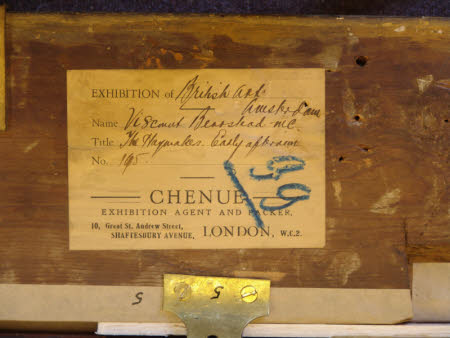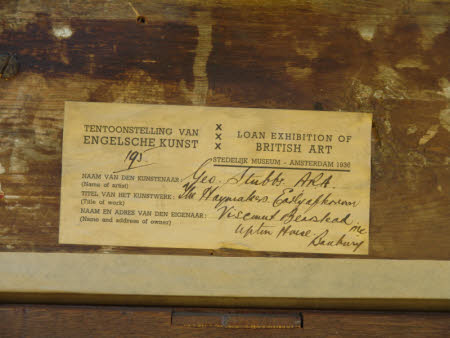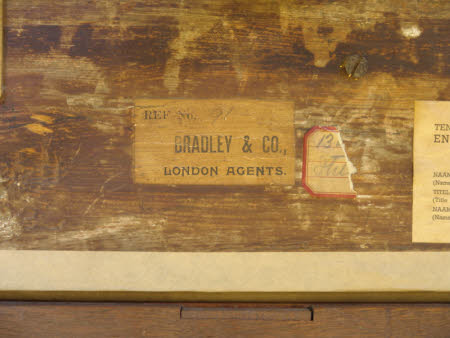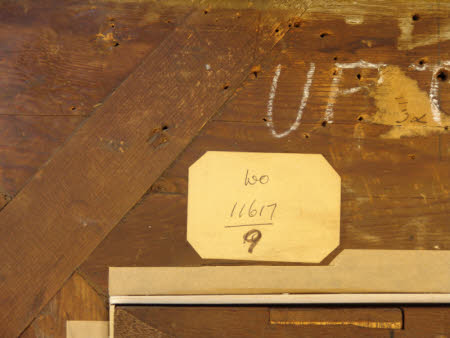The Haymakers
George Stubbs, RA (Liverpool 1724 – London 1806)
Category
Art / Oil paintings
Date
1783 (signed and dated)
Materials
Oil and enamel on oak panel
Measurements
914 x 1372 mm (36 x 54 in)
Place of origin
England
Order this imageCollection
Upton House, Warwickshire
NT 446708
Caption
One of three painted scenes of English rural life the Dining Room at Upton House by George Stubbs, probably better known today as a painter of horses. Although the setting and figures appear to be drawn from life, these scenes of country labour are probably imaginary. The artist was inspired by Gainsborough, Wheatley and Morland and it has been suggested that this particular scene was specifically influenced by Thomas Hearne’s oval watercolour of haymaking, which was exhibited at the Society of Artists in 1783 as A Landscape and Figures from Thompson's "Seasons" and now at Whitworth Art Gallery, Manchester. The elegant black bonnets and dainty shoes of the women imply an idealised depiction of the back-breaking reality of harvesting although, if you look carefully, one of the women has a wooden leg. A later, elaborated, version, also with its companion, The Reapers is, at Tate Britain. Like many paintings by Stubbs, this picture is badly abraded. This may be due to the fact that he was here using enamel colours, which have a very thin consistency. The method of applying this sort of paint was very similar to using watercolours.
Summary
Oil painting and enamel on oak panel, The Haymakers by George Stubbs RA (Liverpool 1724 – London 1806), signed and dated Geo. Stubbs pinxit 1783. A landscape with a group of haymakers at work in the late afternoon. Two women stand by a haywain, one holding a rake, the other turning over hay. A man forks it up to his companion, who reaches over to lift it on to the loaded cart, to which a pair of horses is harnessed; a clump of trees right, and a view over an extensive landscape.
Provenance
Sir Walter Gilbey, 1st Bt (1831-1914) of Elsenham Hall, Essex, by 1898; his sale, Christie's, London, 11 June 1915, lot 387; bought by Agnew; with Knoedler, 1919, from whom acquired by Lord Bearsted, in November 1919, for £1,000; given with Upton House to the National Trust by Walter Samuel, 2nd Viscount Bearsted (1882 – 1948), in 1948, shortly before his death
Credit line
Upton House, The Bearsted Collection (National Trust)
Marks and inscriptions
Geo. Stubbs pinxit 1783 (signed and dated)
Makers and roles
George Stubbs, RA (Liverpool 1724 – London 1806), artist
Exhibition history
Holbein to Hockney, 500 Years of British Art, Fundación Juan March, Madrid, 2012 - 2013 The Bearsted Collection, Whitechapel Gallery, London, 1955, no.9
References
Gilbey 1898 Sir Walter Gilbey, Life of George Stubbs, London, 1898, p.148, No.6 Dibdin 1918 E.R. Dibdin, 'Liverpool Art and Artists in the 18th Century', Walpole Society, VI, 1918, p.64 (note), Pl. XXI Sparrow 1922: Walter Shaw Sparrow, British Sporting Artists, London, 1922, p.129, repd Sparrow 1929 Walter Shaw Sparrow, George Stubbs and Ben Marshall, London, 1929, p.34, repd. Sitwell 1937 Sacheverell Sitwell. Sitwell, Narrative Pictures, London, 1937, pp., 53, 108, Pl.73




